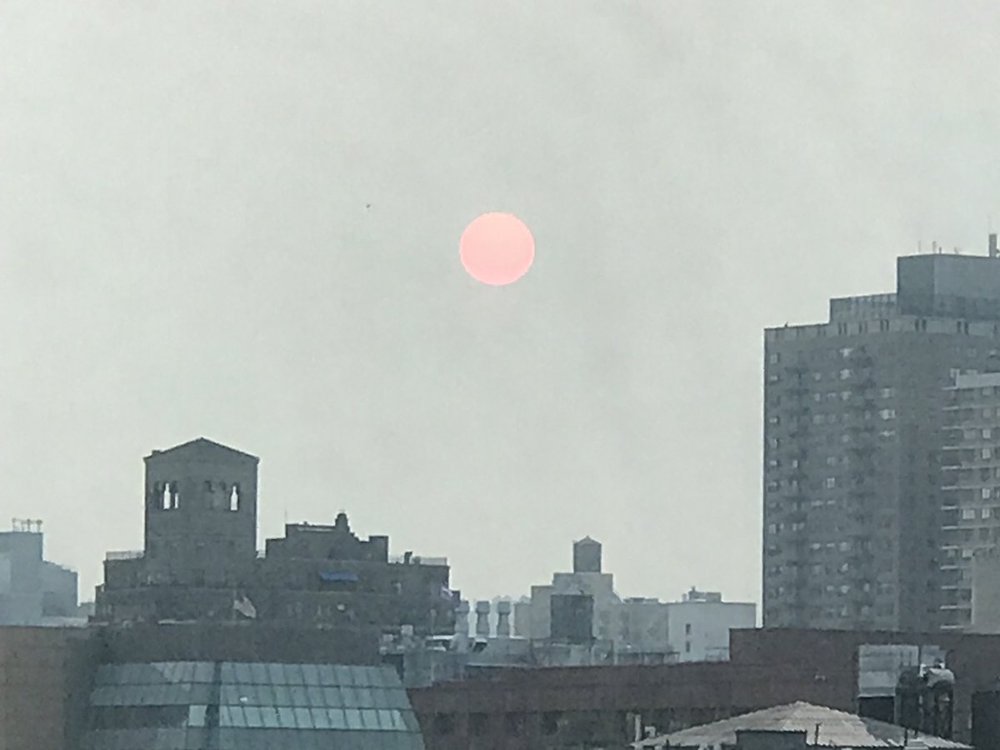Smokey Skies From West Coast Wildfires Offer A "New And Surprising" Climate Crisis Hazard
July 20, 2021, 11:56 a.m.
It's the second time in less than a year that West Coast fires have had a visibly graying effect on our skyline.

Dense layers of smoke emitted by the West Coast wildfires are now suspended above the New York region, blotting an otherwise clear day with dusky skies and poor air quality.
The smoke particles, which are expected to thicken throughout the day, come as roughly 120 fires rage across the western United States, fueled by severe drought and heat waves. In Southern Oregon, the Bootleg Fire has generated its own weather, spawning dangerous "fire clouds" that have led to widespread evacuations.
The effects of catastrophic fires aren't limited to the west. On Tuesday, New Yorkers awoke to hazy skies and a strange red-tinted light, as the sun filtered through clouds of smoke that arrived in our atmosphere from fires nearly 3,000 miles away.
Smoke and haze from the wildfires in the western U.S. can be seen drifting southeast across the Tri-State area in this satellite imagery. This will filter the sunshine here throughout the day today. pic.twitter.com/LfSay79IQy
— NWS New York NY (@NWSNewYorkNY) July 20, 2021
i thought the orange haze in NYC this morning was from the humidity, but apparently it’s wildfire smoke that drifted from the west coast. everything is fine. pic.twitter.com/YZhBjdd1Z9
— crista chapman (@cristaxchapman) July 20, 2021
In addition to turning the sky into a "hazy, milky" color, the tiny smoke particles have also contributed to an Air Quality Index of 134, which is considered unhealthy for sensitive groups, according to National Weather Service meteorologist John Cristantello. A cold front is expected to clear out the remaining smoke in the region on Wednesday.
It's the second time in less than a year that West Coast fires have had a visibly graying effect on our skyline. At the end of last summer, massive clouds of smoke smothered parts of California and the Pacific Northwest, an unprecedented climate-change fueled event that eventually colored the sky above New York.
According to Ben Orlove, a senior research scientist at the Earth Institute of Columbia Climate School, the phenomenon is another reality of the climate crisis that New Yorkers may soon face more regularly.
"We’re used to the heat and humidity. We see that the summer is getting hotter," Orlove told Gothamist on Tuesday. "But we're also seeing something that’s new and surprising: these summer days where smoke comes in, making it unpleasant for everyone, and dangerous for many."
I can barely make out the Statue of Liberty and Lower Manhattan and definitely can’t see midtown from just across the harbor in NYC due to the wildfire smoke. @NWSNewYorkNY pic.twitter.com/mJTvYT1mrh
— Nicholas Isabella (@NycStormChaser) July 20, 2021
Woke up this morning to the most bizarre light. The smoke from the West coast #fires have made it to nyc. I’ll be out shooting this light all day. @capitalweather #fire @LaurieJNYC pic.twitter.com/F2ickXH8Lh
— Jake Price (@jakepricenyc) July 20, 2021
The hazards of poor air quality will fall especially hard on poor communities of color, Orlove noted, where higher rates of emissions lead to greater likelihood of underlying respiratory conditions.
As it stands, the summer is currently on track to be the hottest on record, threatening to accelerate unnatural weather changes that are already being felt across the country, according to a report issued in March by the Environmental Protection Agency.
“There is no small town, big city or rural community that is unaffected by the climate crisis,” Michael S. Regan, the E.P.A. administrator, said at the time. “Americans are seeing and feeling the impacts up close, with increasing regularity.”